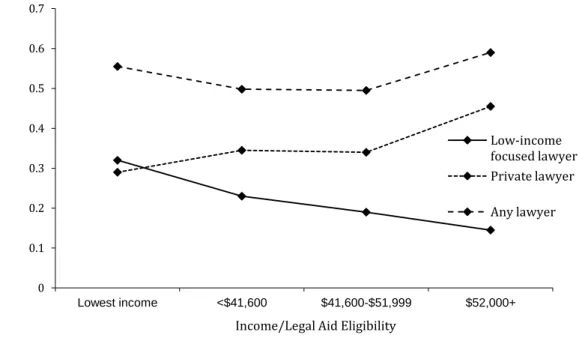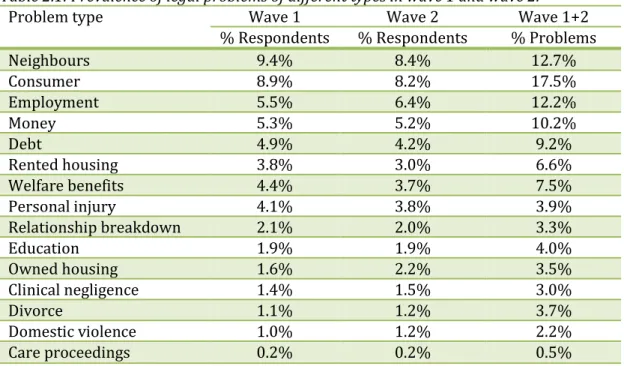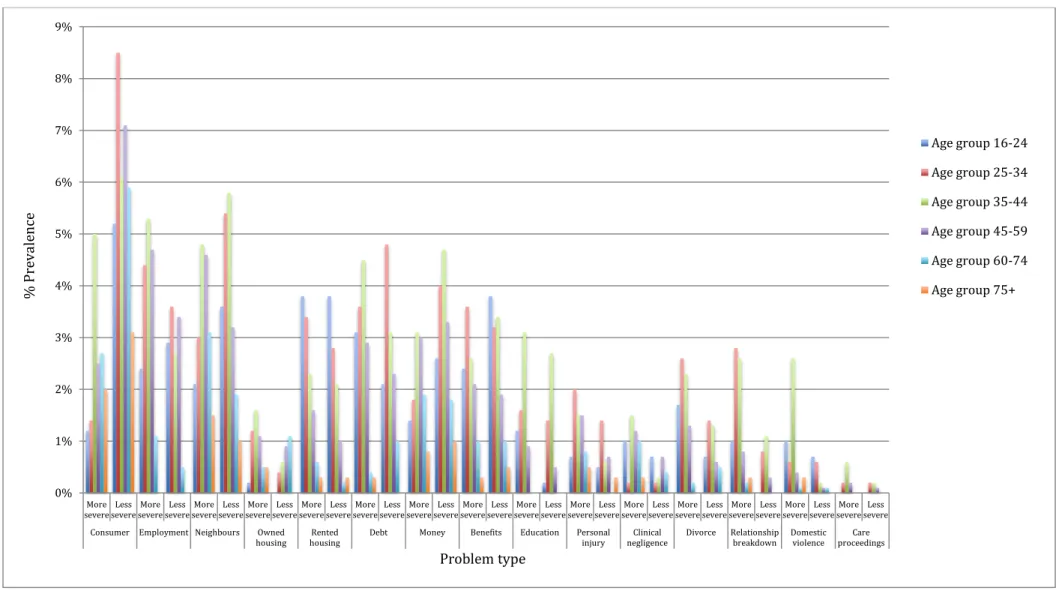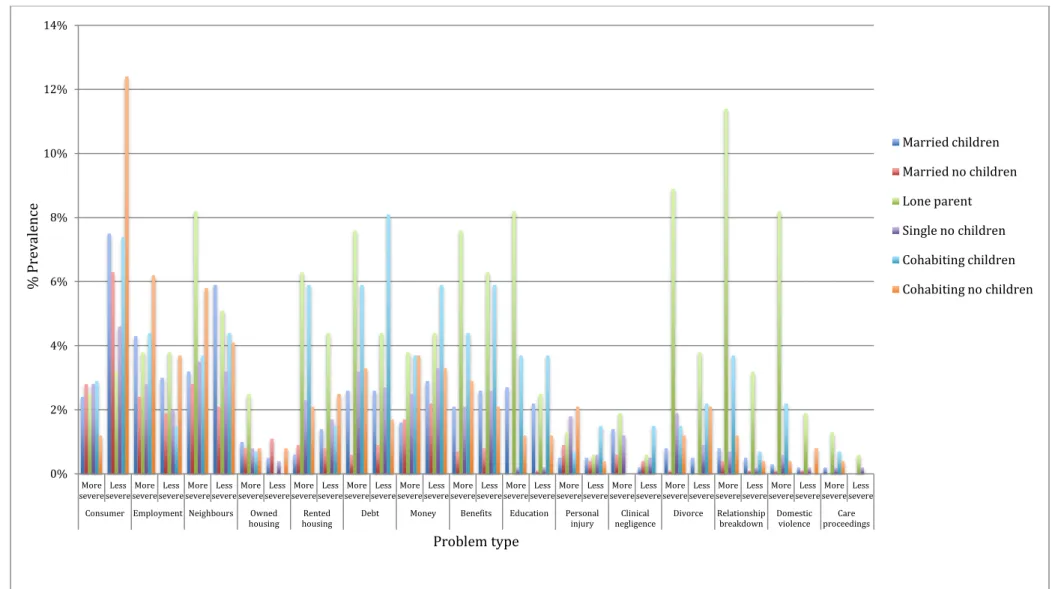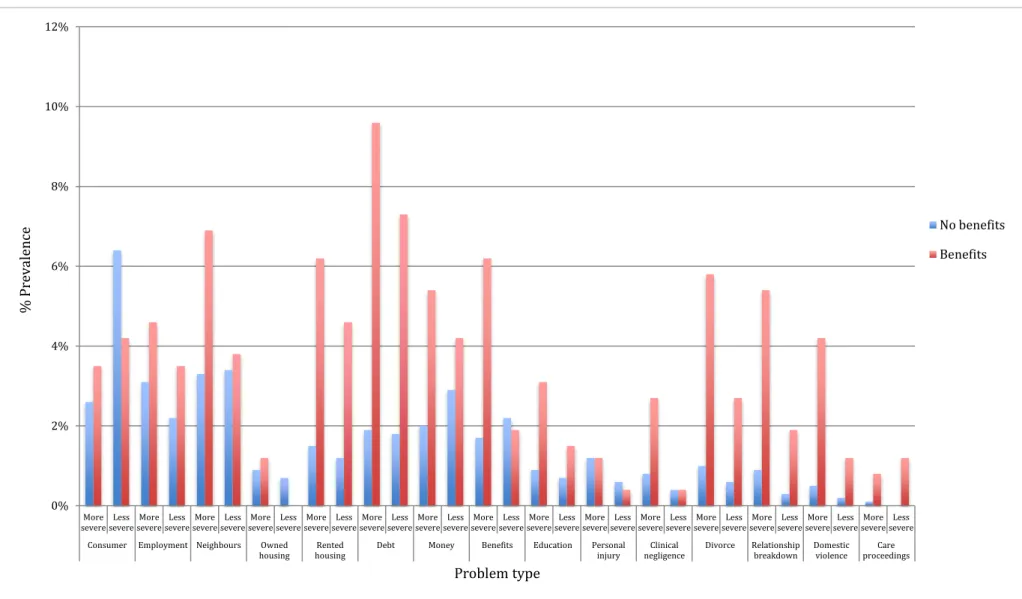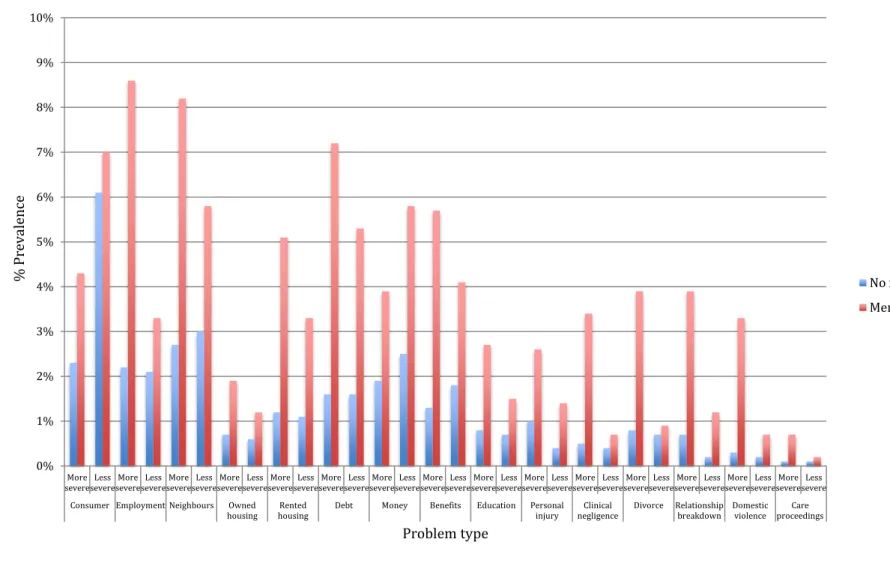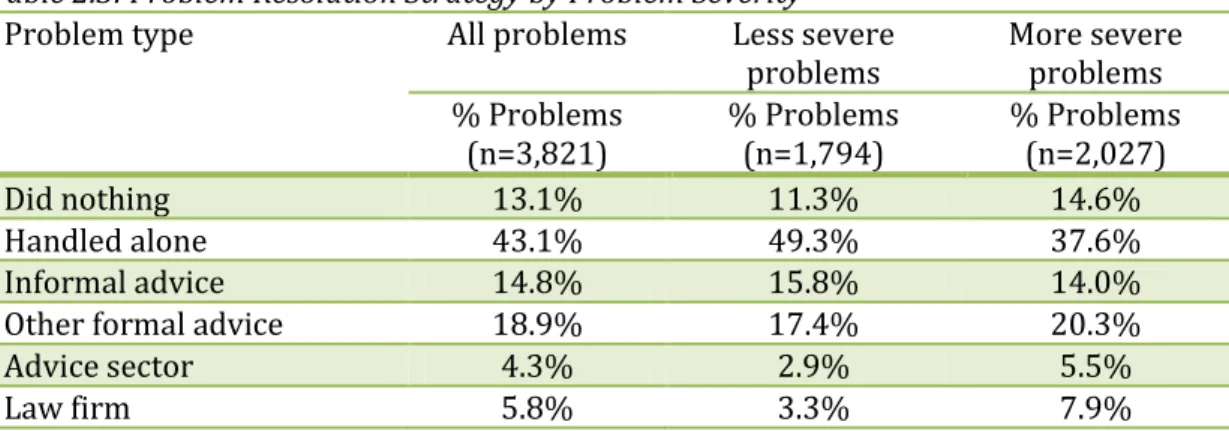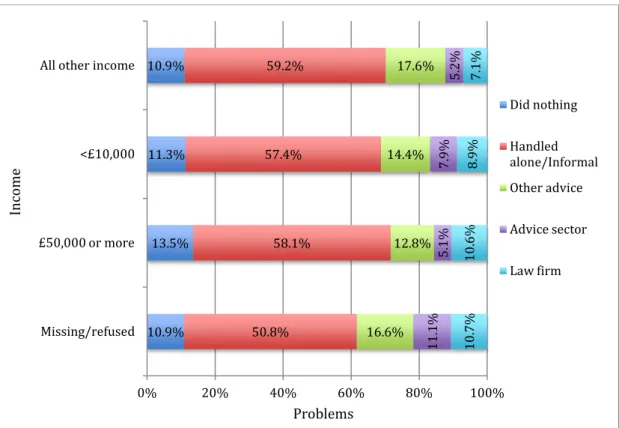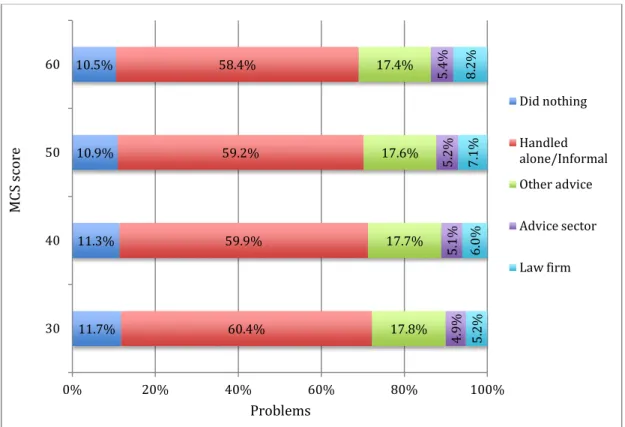How People Resolve ‘Legal’ Problems
Professor Pascoe Pleasence and
Dr. Nigel J. Balmer
Cambridge May, 2014
How People Resolve ‘Legal’ Problems
A REPORT TO THE LEGAL SERVICES BOARD
May 2014
Written by
Pascoe Pleasence Nigel Balmer
© Legal Services Board 2014
Published by PPSR, Cambridge, United Kingdom.
PPSR is a trading name of Pascoe Pleasence Ltd, registered in England No. 7867028.
Registered Office: Unit 11 Hove Business Centre Fonthill Road Hove, East Sussex, BN3 6HA.
All rights reserved. You may not copy, reproduce, republish, post, distribute, transmit or modify in any way without prior written permission. Application for permission for use of copyright material, including permission to reproduce extracts in other published works, shall be made to the copyright holders. Full acknowledgement of copyright holders and publisher must be given.
TABLE OF CONTENTS
Page Key Facts
Executive Summary 1
2
1. Introduction 7
2. The Experience of Legal Problems 18
3. Modelling Responses to Legal Problems 27
4. Reasons and Responses 58
5. The Outcome of Legal Problems 70
6. Discussion 99
Glossary
References 106
107
Key Findings
Courts and law are peripheral to everyday justice.
Fewer than one in ten people experiencing legal problems instruct solicitors Consumer experience does not mirror traditional legal services distinctions including reserved activities
Deficiencies in the civil justice system in meeting consumers’ needs are largely due to difficulty enabling vulnerable populations with limited capability/resources access appropriate help from a complex market.
Increasing severity and duration funnels problems towards law
People are more likely to go to a lawyer in relation to more severe problems, and problems taken to lawyers are more likely to involve the courts.
But, people also often take no action to resolve more severe problems.
Most inaction in response to a problem is rational…. but …
A significant minority of inaction is characterised by helplessness.
Inaction is associated with poorer prospects of effective problem resolution.
Civil law and social injustice
Links between social disadvantage, legal capability and inaction are well illustrated by the Civil and Social Justice Panel Survey.
Problem solving behaviour becomes entrenched over time.
Determinants of advice (and its impact)
Problem characterisation, problem type and cost are key drivers of strategy.
The importance of problem type is a function of both market structure and peoples’ understanding of legal services.
People who characterise problems as ‘legal’ are less likely to ‘lump’ them and far more likely instruct a solicitor.
Choices of sources of help can be unpromising, and where people are forced to look elsewhere they can suffer referral fatigue, getting lost in the system.
The wider advice sector makes a critical contribution to civil justice
Failure to characterise problems as legal does not bear on use of the wider advice sector, with people using it regardless of their understanding.
However, traditional legal practices provide few welfare related services.
Counting costs
Most respondents who obtained help from an advice agency rather than a lawyer said they did so because of the perceived cost.
People’s perceptions of cost can be inaccurate.
Making lawyers cheaper to access may not greatly change consumer behaviour. Public legal education and/or the development of services that meet the public’s perceived needs may also be necessary (Sandefur 2012).
Marketing (the private sector form of public legal education) of personal injury services appears to overcome concerns about cost.
How problems conclude
It is rare for problems to conclude through a legal process.
Problem resolution strategy, problem severity, problem type, psychological factors and respondent mental health are key drivers of form of outcome.
Emotional stability was associated with both a greater tendency to put up with problems and lesser tendency to go to court.
Executive Summary
Introduction
Over the past two decades, at least 26 large-scale national ‘legal needs’1 surveys of the public’s experience of civil (i.e. non-criminal) legal problems have been conducted in at least 15 separate jurisdictions. Comparison of the results of surveys is difficult, owing to differences in methodologies. Nonetheless, recent surveys have yielded a reasonably consistent picture of the main drivers of problem resolution strategy and form of case outcome.
However, to date, no detailed analysis of legal problem resolution strategy or form of case outcome has been undertaken that has simultaneously explored the influence of demographic, capability and problem factors.
In this report we review the evidence to date and then present and integrate the results of detailed new analysis of data from the Civil and Social Justice Panel Survey. This new analysis represents the most detailed analysis of problem resolution strategy and forms of problem outcome undertaken to date.
It has placed a particular focus on the relationship between personal capability and problem resolution strategy/forms of problem outcome, and yielded unique findings in relation to knowledge of rights, subjective legal empowerment,2 the reasons behind different strategy decisions and what drives the form of problem outcome.
A Detailed Picture of Problem Resolution Strategy and Forms of Problem Outcome
Not everybody who experiences a legal problem will take steps to resolve it.
Fewer than one in ten will instruct a traditional lawyer (i.e. a private practice solicitor or barrister), and only around one in twenty will see it resolved through a court, tribunal or other third party decision. The courts are thus peripheral to much everyday justice. Though, this does not mean we face a crisis of lack of
‘access to justice’ (despite recent changes to the legal aid scheme in England and Wales certainly diminishing people’s ability to obtain legal help when needed), as people do not systematically act irrationally or in ignorance.
Severity, Inaction and Capability
Civil and Social Justice Panel Survey (CSJPS) respondents were more likely to obtain assistance from a traditional lawyer in relation to more severe problems.
The same was also true of the wider advice sector. This suggests, in Kritzer’s (2008, p.903) words, “market rationing” of legal services – i.e. access by only
1 Legal need is a contested concept. It has been used to refer to occasions when people experience legal problems but fail to obtain the services of lawyers to assist with their resolution. However, it is generally recognised that legal mechanisms do not always provide the most appropriate route to solving problems that raise legal issues (e.g. Lewis 1973, Blacksell et al 1991). Attempts to define legal need have therefore come to place emphasis on understanding of options and preferences (e.g. Hughes 1980, Ignite Research 2006, Coumarelos et al 2012).
2 Subjective legal empowerment is the self-belief that an individual can solve problems of a legal
those that really need it. However, in simple numerical terms, respondents also more often took no action to resolve more severe problems, and while most inaction is rational inaction, a significant minority of cases of inaction are characterised by helplessness and powerlessness.
Problem resolution behaviour is unequivocally tied to legal capability, with action more likely among those with higher subjective legal empowerment scores, who understand their rights and/or see problems as having a legal character. Problem resolution behaviour is also ‘learned’ (both individually and within households), meaning that it is likely to recur when new problems are faced. Thus, diminished capability, in lessening people’s initial ability to resolve problems may also contribute to ‘frustrated resignation’ (Sandefur 2007) and an increasing likelihood of ‘lumping’ problems. And this is of great significance as inaction is, in turn, associated with far poorer prospects of effective problem resolution.
Characterisation of Problems, Choice of Adviser and the Legal Services Market In relation to choice of adviser, three dominant factors have emerged from the CSJPS; problem characterisation, problem type and cost. Problems that CSJPS respondents characterised as ‘legal’ were less likely to be ‘lumped’. They were also less likely to be handled by respondents themselves, but far more likely to result in help being obtained from a law firm. While, we live in a “law thick”
world (Hadfield 2009), most of us do not see it as such, and we behave accordingly.
Importantly, though, failure to characterise problems as legal has no bearing on use of the wider advice sector or other formal sources of advice. This demonstrates the profound importance of the broad advice sector “to the accessibility of legal services and, ultimately, justice.” (Pleasence, Balmer and Reimers 2010).
Characterisation is linked to problem type. Different types of problems tend to be more or less associated with law, with patterns of behaviour reflecting this. As we noted in relation to the 2001 CSJS, “while 25 per cent of all English and Welsh solicitors’’ non-corporate income (and more than 20 per cent of smaller firm solicitors’ income) relates to negligent accidents, 9 per cent relates to employment problems and less than 1 per cent relates to problems concerning welfare benefits (Law Society 2003) … this is despite incidence of problems being similar for all three problem types, all three problem types having a potentially serious impact on people’s lives and all potentially involving complex legal issues.”
But characterisation and problem type independently influence problem resolution behaviour. There are therefore other aspects of problem type that are in play here. One may be the absolute value of problems. As Kritzer (2008) has stressed, there are evident “cost-benefit calculations” applied in people’s choices about whether to use lawyers. Also, there is the structure of the legal services market. Traditional legal practices may not be inclined to provide services to relatively poor clients in relation to basic welfare issues they find it hard to profit from.
The Cost of Law
Recent years have seen increasing evidence come to light of cost acting as a
barrier to the use of lawyers. Where legal aid is most available, there appears to be a ‘U’ shaped relationship between income and lawyer use. Where no legal aid is available, there is a simpler relationship, with access increasing along with income; except where conditional/contingent fees (or an equivalent form of alternative payment mechanism) are available, in which case there appears to be no relationship. Our new findings from the CSJPS confirm that cost is a live issue among those looking to resolve legal problems. 57% of CSJPS respondents who obtained help from an advice agency rather than a lawyer indicated that they did so because of the perceived or actual cost of instructing a lawyer.
To the extent that preference is based on cost, reduction in cost might therefore act to increase that rate at which law firms are instructed. However, it is not clear that public understanding of the cost of lawyers is particularly nuanced. It may be that in addition to perception of the nature of problems being a factor in problem resolution behaviour, perception of the cost of lawyers is also a factor.
Because behaviour “is a function of more than the services’ cost,”
Sandefur (2012) has suggested that there are two options to addressing any erroneous perceptions of lawyer costs. One would be through public legal education. But another, “alternative or complementary strategy might be to ask people about the kinds of help they would like with their [problems] and then develop services that meet people’s own perceived needs – even if those services turn out not to be traditional legal services.”
The advice sector and new lower cost entrants to the legal services market constitute more diverse and affordable elements of the legal services market; a point made by Hadfield (2009) in noting that “the extreme approach to the unauthorised practice of law in the United States drastically curtails the potential for ordinary folks to obtain assistance with their law-related needs and problems.”
‘Other’ Advisers, the Advice Maze and Referral Fatigue
Our new findings confirm that people seek advice from a broad range of sources.
Fifteen per cent of problems see formal help obtained from beyond both the recognised advice sector (e.g. from health professionals, social workers, employers and politicians). As Pleasence et al. (2004, p.69-70) have observed,
“some confusion and desperation” is sometimes evident in choices of sources of help, with some “seemingly inappropriate and unpromising.” And where people make inappropriate choices, they must then look again, or be signposted/referred on to new advisers, and each time this happens a proportion will give up (‘referral fatigue’). This highlights the importance of a visible and coherent legal services market.
Duration and Reasons for Obtaining Independent Help
Our new CSJPS findings showed that shorter duration problems were more likely to have been handled by CSJPS respondents themselves. According to respondents’ reasons for obtaining independent help, lengthier problems were sometimes those they had been unsuccessful in resolving by themselves. But more often, respondents recognised that they needed help in order to resolve their problems. Echoing Galanter’s (1974) discussion of ‘one-shotters’ and
‘repeat players’, a small number of respondents made explicit reference to the need “to be on equal terms.”
Elsewhere, as with inaction, some respondents also said their main spur to getting independent help was fear or intimidation. These respondents looked to independent help to extricate them from their predicament. Unexpectedly, though, and in greater harmony with the generally civil nature of dispute resolution, there were also respondents who explained their use of independent help as a means to engage with the other party without threatening or physically hurting them.
Drivers of Process
Statistical modelling identified a number of factors as having a significant bearing on the form of problem outcome, with strategy, problem severity, problem type, psychological factors and respondent mental health standing out.
In the same way that more severe problems tend to be channelled towards independent help and law firms, so both severe problems and those involving law firms have a greater tendency to involve formal process and resolve in court. In contrast, problems that are handled alone are less likely to end in court. Thus the market rationing exposed in relation to legal advice is also apparent in relation to formal process.
Elsewhere, problem type was again shown to be a key driver of form of outcome and, again, cultural norms are likely to in part inform parties’ decisions.
Also, emotional stability was associated with both a greater tendency to put up with problems and lesser tendency to go to court.
Challenges for the Future
Market rationing can be seen to act to channel more severe legal problems into advice and legal services (and, beyond that, formal process). However, it is apparent that this form of rationing has its limits. Lesser legal capability prevents people taking action to resolve problems where others would do so (with inaction more common for more severe problems) and, when action is taken, is influential in determining choices of strategy and sources of help. In addition to this, cost (or, at least, perceived cost) is evidently an important factor in decisions concerning sources of help. Though the social construction of appropriateness in dispute resolution, through institutionalised behaviours, no doubt somewhat diminishes cost sensitivity in the legal services sphere.
These findings make clear the challenge that remains to further improve the civil justice rationing process, whether through targeted services, public legal education (or marketing, in the private sphere), or the development of new forms of services that better meet the needs of the public, even though these may look very different from traditional legal services. And while public legal education faces a tough task in altering deep rooted perceptions and beliefs, the success of marketing in the private sector (e.g. in relation to personal injury claims) offers some hope.
To the extent that beliefs reflects the reality of legal costs, the role of cost in decision making also makes clear the challenge to further innovate to provide legal services for people with different levels of resources. And never has this
been so important than at the time when civil legal aid is undergoing such considerable change.
Our findings concerning choice of sources of help in relation to legal problems also again makes clear the challenge of making gateway legal services more visible and the legal services market more navigable.
Finally, the findings that longer duration problems are more likely to be those that involve lawyers, and then that problems involving lawyers are more likely to be determined through the courts raises again the challenge of more timely forms of intervention to enable earlier resolution of legal disputes.
In Conclusion
The findings set out in this report provide a more detailed picture of the factors that influence legal problem resolution behaviour and the form of outcome than has previously been available. They confirm the complexity of behaviour, and the importance of problem severity, problem type and perceptions/understandings.
Our findings do not suggest any broad crisis of access to justice, with market rationing operating to channel more severe problems towards advice and formal process and some inaction appearing entirely rational. However, the legal services market and civil justice system do not ensure fair and equal access to justice, with deficiencies attributable largely to the difficulty of enabling vulnerable populations with limited capability and resources (e.g. those with health problems, low levels of education and/or lower income) to access appropriate help in a complex legal services market in which innovations to broaden service reach have often emanated from outside of the traditional legal professional sphere.
The findings in this report suggest similarities between the experiences of individuals and businesses. Elsewhere (Pleasence and Balmer 2013) we have shown the importance of problem severity, problem type and business capability/resources to businesses’ responses to legal problems. Here, also, market rationing and unequal access to justice are evident – with smaller businesses generally at a disadvantage.
1
A Tradition of Surveys
Over the past two decades, at least 26 large-scale national ‘legal needs’ surveys of the public’s experience of civil (i.e. non-criminal) legal problems have been conducted in at least 15 separate jurisdictions: Australia, Bulgaria, Canada, England and Wales, Hong Kong, Japan, Moldova, the Netherlands, New Zealand, Northern Ireland, Scotland, Slovakia, Taiwan, Ukraine and the United States (Table 1.1).3 Extensive sub-national surveys have also been conducted in China,4 Russia,5 and various of the jurisdictions just listed.6
3 Reese and Eldred (1994), Genn (1999), Maxwell et al (1999), Genn and Paterson (2001), Pleasence et al (2004), Currie (2005), GfK Slovakia (2004), Van Velthoven and ter Voert (2004), Currie (2007), Dignan (2006), Ignite Research (2006), Pleasence (2006), Murayama (2007), Sato et al (2007), Asia Consulting Group Limited and Policy 21 Limited (2008), Currie (2009), Tamaki, T. (2009), Pleasence et al (2010), Van Velthoven and Haarhuis (2011), Pleasence et al (2011), Chen et al (2012), Coumeralos et al (2012), Pleasence et al. (2013). Details of the Bulgarian and Moldovan surveys reported in Pleasence et al. (2013), citing correspondence with the surveys’
author, Martin Gramatikov. If the civil justice modules of the annual Scottish Crime and Justice Surveys (first conducted in 2008/9) were included, the figure would be higher. The modules have not been included as they form only small sections of the survey. In addition, only outline findings have been reported.
4 Michelson (2008)
5 See Pleasence et al. (2013), citing correspondence with the surveys’ author, Martin Gramatikov.
Introduction
Summary
Recent legal need surveys have yielded a reasonably consistent set of factors associated with problem resolution strategy. In demographic terms, these include gender, age and education. In problem terms, these include value, severity and problem type. It also appears that geographical, technological and other physical and structural access issues (e.g. opening times, service availability, distance to services, funding availability, mode of service delivery, service cost, service integration) influence problem resolution behaviour; as do beliefs about law, lawyers and dispute resolution, and people’s perceptions of the issues they face.
9% of legal problems reported through the 2006-9 CSJS saw no action taken to resolve them. For around 40% of these problems, respondents provided reasons for inaction that suggested diminished capability. 49% of problems involved advice being obtained (from a wide range of sources), and 41% saw an unsuccessful attempt to obtain advice or problems handled alone. Not all choices of adviser are appropriate and ‘referral fatigue’ can prevent people from successfully obtaining appropriate advice.
Different problem resolution strategies are associated with different means of problem conclusion, with advice associated with higher rates of conclusion through court or tribunal processes. The means of problem conclusion also varies by problem type.
In this report we use data from the English and Welsh Civil and Social Justice Panel Survey (CSJPS) to build upon the above evidence base and explore in more detail the factors that influence legal problem resolution behaviour.
Legal needs surveys originate from the 1930s recession at the United States’ Bar,7 though only towards the end of the 20th Century the conduct of such surveys “gain considerable momentum” (Coumarelos et al. 2012, p.1);
particularly following high profile national surveys in, first, the United States, then England and Wales, New Zealand and Scotland.8 This momentum has been fuelled by the establishment or reform of legal aid across the developed world.9 Table 1.1: National Legal Need Surveys (Last Two Decades)
Country Date Study Size
Australia 2008 Law Australia Wide Survey 20716
Bulgaria 2007 Access to Justice and Legal Needs Bulgaria 2730 Canada 2004 National Survey of Civil Justice Problems 4501
2006 6665
2008 7002
England and Wales 1997 Paths to Justice 4125
2001 Civil & Social Justice Survey (CSJS) 5611
2004 5015
2006-9 10537
2010 Civil & Social Justice Panel Survey (CSJPS) 3806
2012 3911
Hong Kong 2006 Demand & Supply of Legal & Related Services 10385 Japan 2005 National Survey of Everyday Life & the Law 12408 2006 Access to Legal Advice: National Survey 5330
2007 Everyday Life and Law 5500
Moldova 2011 Met and Unmet Legal Needs in Moldova 2489 Netherlands 2003 Paths to Justice in the Netherlands 3516
2009 5166
New Zealand 1997 Legal Advice & Assistance Survey 5431 2006 Unmet Legal Needs & Access to Services 7200 N. Ireland 2005 Northern Ireland Legal Needs Survey 3361
Scotland10 1998 Paths to Justice Scotland 2684
Slovakia 2004 Legal Needs in Slovakia 1085
Taiwan 2011 Legal Dispute Settlement Behaviour 5601
Ukraine 2010 Legal Capacity of the Ukrainian Population 2463 United States 1993 Comprehensive Legal Needs Study 3087
6 For example, over the past two decades, surveys have been conducted in at least 16 of the 50 US states, as well as in other jurisdictions such as Australia (Coumarelos et al 2006) and Canada (Baxter et al 2012).
7 Clark and Corstvet (1938),
8 Reese and Eldred (1994), Genn (1999), Maxwell et al. (1999) and Genn and Paterson (2001).
They were themselves influenced by an earlier wave of surveys including, most notably, the Civil Litigation Research Project is evident (Trubek et al 1983), which also led to efforts of replication (e.g. Bogart and Vidmar 1990).
9 e.g. Legal Aid Act 2004 (Taiwan), Legal Aid Act 2005 (Bulgaria); Legal Aid Act 2007 (Moldova), Legal Aid, Sentencing and Punishment of Offenders Act 2012 (England and Wales).
10 Not included in this list are the Scottish Crime and Justice Surveys, which have been conducted annually on a continuous basis (April to March) since 2008/9. The civil justice module for the 2008/9 survey had 7,971 respondents (half of the total survey sample), while the civil justice modules for the 2009/10 and 2010/11 surveys each had 3,984 respondents. In the phrasing of questions, the modules could be said to follow the Paths to Justice approach to identifying justiciable problems (although utilising different wording). However, the inclusion of only 5 main questions in 2008/9 and 8 questions in the 2009/10 and 2010/11 surveys entails that they are
In England and Wales, following Genn’s landmark Paths to Justice survey in 1997, the first CSJS was conducted in 2001, then again in 2004 and from 2006 to 2009 on a continuous basis, with fieldwork conducted throughout the period.
The CSJS was originally funded to enable government performance management, with the survey first adopted to measure progress against government Public Service Agreement (PSA) targets around access to legal services. They were subsequently used to measure “equal protection and support for individuals with civil justice problems” within the Equality Measurement Framework (Alkire et al 2009). The conduct of the CSJS has also been seen by the Legal Services Commission as central to discharging its statutory duty to “inform itself about the need for, and the provision of Community Legal Service services,” under Section 4(6) of the Access to Justice Act 1999.
From 2010 the survey moved to a longitudinal panel format (the CSJPS - the first legal need survey adopting the design) with respondents re-interviewed after around 18 months in early 2012. The panel survey design allows unconcluded problems to be followed up, providing better insight into the development of problem resolution behaviour over time, more accurate ordering of life events, and the accumulation of more extensive demographic data. The CSJPS surveys were funded by the Legal Services Commission.
This report focusses primarily on the 2010 and 2012 waves of the CSJPS, which in terms of detail, is the most extensive legal need survey undertaken worldwide.
Mirroring developing understanding of ‘legal needs’, and general recognition that legal mechanisms do not always provide the most appropriate route to solving ‘legal’ problems,11 more recent legal needs surveys have adopted a neutral stance towards consumer behaviour. One consequence of this has been a broader and more nuanced examination of problem resolution strategies.
While comparison of the results of surveys is difficult, owing to differences in methodologies,12 recent surveys have yielded a wide range of influential findings concerning consumer responses to legal problems.13
As Pleasence et al. (2013, p.33) have noted, a “reasonably consistent” set of factors associated with broadly defined problem resolution strategies has emerged from multivariate analysis. In demographic terms, these include gender, age and education. In problem terms, these include value, severity and problem type.
Responses to Legal Problems: Survey Findings to Date Inaction
Not everybody who experiences a legal problem will take steps to resolve it.
Since Felstiner, Abel and Sarat (1981) developed their influential five-part aetiology of how ‘injurious experiences’ may become lawsuits – involving the recognition of circumstances as injurious (naming), the identification of them as a grievance for which another is responsible (blaming), and the confrontation of the wrongdoer with a complaint (claiming) – it has been widely recognised that
11 e.g. Lewis (1973), Blacksell et al. (1991)
12 Pleasence et al. (2013)
13 However, it should be noted that, though 26 large-scale surveys have been undertaken, analyses of consumer behaviour have not always been reported, and multivariate analyses have been undertaken in respect of fewer than half the surveys listed in Table 1.1.
people may ‘lump’ legal problems for many reasons. People may not recognise their circumstances as problematic.14 And even if circumstances are recognised as problematic, people may not act to address them if, for example, problems are expected to resolve themselves, action is seen as unlikely to succeed (as in the case of the socially stratified fatalism described by Sandefur (2007)), or action is seen as involving unacceptable risk, or cost (in time or money terms).
The surveys listed in Table 1.1 have generally put the rate of inaction in the face of legal problems at between 10% and 20%. For example, the 2006-9 English and Welsh Civil and Social Justice Survey (CSJS), the largest survey undertaken in this jurisdiction, indicated that 9.4% of ‘difficult to solve’ legal problems see no action taken to resolve them (Pleasence et al. 2010). For 43% of these 575 problems, inaction was simply a consequence of problems not involving dispute, being relatively trivial or resolving without the need for action. However, for 21% of the 575 problems, respondents said that action would make no difference, for 8% they did not know what to do or who to go to, for 6% they were uncertain of their rights, and for 6% they were scared to act.15 Thus, for around 40% of these problems, respondents provided reasons for inaction that suggested diminished legal capability,16 and in only a few of these cases did respondents provide other reasons that placed their inaction in a better light.
Drawing on those surveys in which multivariate analyses have been undertaken, inaction appears to be more common among men, younger people and those with fewer educational qualifications. It is also more common in relation to problems concerning anti-social neighbours, along with, unsurprisingly, lower value and less severe problems. Inaction is rare in the case of family problems.
Advice
The surveys listed in Table 1.1 point to seeking formal advice being the most common response to legal problems. For example, the 2006-9 CSJS found that 49.2% of ‘difficult to solve’ legal problems involved advice being obtained (usually from an independent source), while 40.6% saw an unsuccessful attempt to obtain advice (7.7%) or problems handled alone.
Respondents reported having obtained advice from a wide range of sources. Solicitors firms, local authorities, the police and Citizens Advice Bureaux were the most common, but Pleasence et al. (2010) also documented advice as having been sought from other advice agencies, trade unions and professional bodies, employers, insurance companies, claims agencies, Jobcentres, government departments, court staff, health workers, social workers, trade associations, financial institutions, politicians, churches, housing associations, the media, banks and schools.
14 As we have discussed elsewhere, the propensity to see circumstances as problematic is not fixed across populations (Pleasence et al. 2004). Indeed, what one person sees as problematic, another may see as positive.
15 Linked to this, in 5% of cases respondents were worried about damaging their relationship with the other side.
Pleasence et al. (2010) reported that 2006-9 CSJS respondents most often established contact with advisers via the telephone (52%), with face-to-face meetings also common (37%).
Figure 1.1: Percentage of Referrals that are Successful (Pleasence 2006)
It is clear that not all choices of adviser are appropriate – with Pleasence et al. (2004) describing “confusion and desperation” in relation to some choices. A significant proportion of advice seekers therefore end up moving from one adviser to another, giving rise to the phenomenon of ‘referral fatigue’ (Figure 1.1), meaning “that the likelihood of [people] obtaining advice from an adviser to whom they had been referred declined as respondents visited more advisers”
(Pleasence et al. 2004, p.77).
Drawing on those surveys in which multivariate analyses have been undertaken, as can be seen from Table 1.2, advice seeking appears to be more common among women,17 older (but not oldest) people and those with more qualifications. It is also more common in relation to higher value and more serious problems, and problems concerning family, personal injury, employment and owned housing. Advice is rare in the case of problems concerning consumer issues and debt.
It also appears that broader social and cultural factors (e.g. language),18 and geographical, technological and other physical and structural access issues (e.g. opening times, service availability, distance to services,19 mode of service
17 This gender difference has not been found in relation to legal advice (Maxwell et al 1999, Pleasence and Balmer 2008)
18 e.g. Coumeralos (2012)
19 Proximity to legal services appears to influence mode of access more than the fact of access to advice, with telephone becoming more prominent with distance (Patel et al 2008).
0 50 100
First adviser Second adviser Third adviser
Percentage of successful referrals
Number of adviser in sequence
2004 2006
delivery,20 service cost, service integration) influence problem resolution behaviour.21
Table 1.2 Reported Predictors of Advice (from Pleasence et al. 2013)
Predictor Jurisdiction
Australia 08 England 97 England 01 England 04 England 10* Netherlands 03 Netherlands 09 New Zealand 06 Scotland 98 Taiwan 11
Compared with NA HA HA NL HA HA NA NA HA
Gender (Male) = = n/r n/r n/r = =
Age (increasing) ∩ ∩ ∩ n/r ∩ = =
Ethnicity (BME) = n/r ** ** n/r n/r n/r = n/r n/r
Family Status LP n/r = = n/r M D = n/r =
Income (increasing)
n/r
22 = = = U U = n/r
Education = = n/r Mix = n/r = =
Illness/disability n/r = = n/r n/r n/r = n/r n/r Value (increasing) n/r n/r n/r n/r n/r
Seriousness n/r n/r n/r n/r n/r
Consumer Ref
Debt n/r n/r n/r n/r n/r n/r n/r n/r
Domestic violence n/r n/r = = n/r n/r n/r n/r n/r n/r
Employment Ref = =
Family
Neighbours n/r = = n/r n/r n/r =
Owned housing n/r = = = n/r
Rented housing n/r = = n/r = n/r =
Personal injury = n/r
Welfare benefits n/r n/r = = n/r n/r n/r n/r n/r
* = Advice from a lawyer, ** = Black, n/r = not reported
‘=’ indicates that no association was observed. Specific association are detailed by direction or category.
HA = Handled alone, NA = No advice, NL = No lawyer
∩ = ∩-shaped distribution, U = U-shaped distribution, D = Divorced/separated LP = Lone parent, M = Married, = Positive relationship, = Inverse relationship.
20 For example, different demographics are also associated with different propensities to use different modes of communication with advisers, with Denvir et al. (2011) suggesting that young people, while heavy users of online services, are not great users of online advice services.
21 e.g. Genn (1999), Genn and Paterson (2001), Pleasence et al. (2004), Murayama (2009), Patel et al. (2009), Chen et al. (2012), Coumeralos et al. (2012), Pleasence and Balmer (2012)
22 Forthcoming findings indicate a mixed picture, with a U-shape discernible for problems for
Use of Lawyers23
Looking in more detail at lawyer use, problem type has been repeatedly identified as a key influence, with family related problems most associated with lawyers. In fact, as Pleasence et al. (2013, p.34) report, lawyers were most frequently instructed to help resolve family problems “in 19 of 20 surveys for which findings are available.” The exception was Moldova, where family came second. Problems concerning owned housing and personal injury are also strongly associated with lawyer use.
This has inspired inquiry into what underpins associations between problem type and lawyer use.24
Figure 1.2: Using a Lawyer by Income/Legal Aid Eligibility and Legal Aid Availability (2006-9 English and Wales Civil and Social Justice Survey, Pleasence and Balmer 2012)
Pleasence and Balmer (2008, p.245) have posited that different levels of lawyer use for different problem types is likely to in part reflect different levels of supply, with profitability and the dominance of traditional areas of legal practice being instrumental in this. They pointed to the fact that 25 per cent of all English and Welsh solicitors’ non-corporate income relates to negligent accidents, 9 per cent to employment problems and less than 1 per cent to problems concerning welfare benefits (Law Society 2003), “despite incidence of problems being similar for all three problem types, all three problem types having a potentially serious impact on people’s lives and all potentially involving complex legal issues.”
Evidently, problem severity (which varies by problem type) is also related to lawyer use, and Pleasence et al. (2011) and Pleasence and Balmer (2012) have demonstrated clear associations through multivariate analyses.
Multivariate analyses in England and Wales, Australia and Taiwan25 also suggest an association between relative resources (e.g. income) and lawyer use,
23 This generally refers to private practice lawyers, but there is inconsistency between surveys as to the precise definition.
24 e.g. Kritzer (2008) and Pleasence, Balmer and Reimers (2011) 0
0.02 0.04 0.06 0.08 0.1 0.12 0.14 0.16 0.18 0.2
LA eligible <£15,000 £15-24,999 £25-39,999 £40,000+
Probability of Using a Lawyer
Income/Legal Aid Eligibility
Most available Other
but (critically), one that is mediated by the availability of legal aid, alternative funding schemes (such as conditional or contingent fees) and the structure of the market for legal services.
In both England and Wales and Australia a U-shaped association between income and lawyer use appears to be produced by the availability of legal aid for those on the lowest incomes in the case of problem types for which legal aid is most available. Figure 1.2 illustrates this for England and Wales. Figure 1.3 illustrates this for Australia, with the additional subtlety that different lawyers are utilised by those at the lower and higher ends of the income scale. Also, in both jurisdictions, income was found not to be related to the use of lawyers in relation to personal injuries, where alternative funding mechanisms are available. For other problem types lawyer use was generally low, but there was evidence of lawyer use becoming more widespread as income rose.
Figure 1.3: Using a Lawyer for Family Problems by Income (Australian LAW Survey, Pleasence and Macourt 2013)
Supporting multivariate findings, respondents to various surveys have also reported cost (which could be perceived and/or actual) as a barrier to accessing lawyers.26 For example, Genn and Paterson reported that respondents to the Scottish Paths to Justice Scotland surveys “expressed a pervasive feeling that obtaining legal advice was hugely expensive and that for many kinds of problems obtaining such advice was simply not an option” (p.105). However, as Kritzer (2008) has argued, associations between income and lawyer use remain modest compared to those between problem type and lawyer use. 27
25 Pleasence and Balmer (2012), Pleasence and Macourt (2013), Huang et al. (forthcoming).
26 e.g. Genn (1999), Genn and Paterson (2001) and Genn and Paterson (2001)
27 The 2009 Paths to Justice in the Netherlands Survey explored the relationship between legal expenses insurance (LEI) and access to lawyers. For higher-income citizens it was found that LEI increases access to lawyers, while for lower-income citizens, no net change was observed: van
0 0.1 0.2 0.3 0.4 0.5 0.6 0.7
Lowest income <$41,600 $41,600-$51,999 $52,000+
Probability of Using a Lawyer
Income/Legal Aid Eligibility
Low-income focused lawyer Private lawyer Any lawyer
Figure 1.4: Probability of Seeking ‘Advice Sector’ Advice on the Basis of Problem Type and Whether or not the Problem was Characterised as ‘Legal’ (Pleasence et al. 2013b).
Elsewhere, there is increasing interest in “exploring how problem resolution behaviour is influenced by beliefs about law, lawyers and dispute resolution, and people’s perceptions of the issues they face and their motivations in addressing issues through particular channels” (Pleasence et al. 2013, p.63).
As Pleasence et al. (2013) go on to observe, “This is beginning to conjoin theories of legal consciousness and legal empowerment with the Paths to Justice tradition of research.”
For example, The 2005 Japanese National Survey of Everyday Life found that whether people perceive problems ‘legal’ is an important influence on lawyer use.28 Using data from an online survey, Pleasence et al. (2011) also found that characterisation of problems as ‘legal’, rather than moral, social, criminal, etc., greatly increases the likelihood of people considering lawyers as a solution (Figure 1.4). Importantly, though, people’s consideration of general advice services generally remains constant, irrespective of characterisation (Figure 1.5).
28 Murayama (2009)
0 0.2 0.4 0.6
PI not caused by another Neighbours problems Divorce PI caused by another Child protection Assault by the police Problems ancillary to relationship … Problems with childrens education
Clinical negligence Problems to do with nationality Problems renting out housing Problems with owned housing Discrimination Problems lending money Faulty goods and services Problems with rented housing Debt problems Problems with benefits grants and …
Homelessness (threat or actual) Employment problems Problems with financial services
p(advice sector advice) Legal Not legal
Figure 1.5: Probability of Seeking Advice Sector Advice on the Basis of Problem Type and Whether or not the Problem was Characterised as ‘Legal’ (Pleasence et al. 2011).
Gramatikov (2008) has also highlighted, using the 2007 Bulgarian survey data, how cultural expectations of how particular problem types are resolved directs behaviour. He explains that “still, many of the citizens of [East European countries] expect the state to play extensive corrective role in cases when their private lives, rights and interests are endangered” (p.11).
Gramatikov and Porter (2011) have also started to inquire into how confidence in resolving disputes, termed subjective legal empowerment, impacts on problem resolution behaviour. And linked to this, findings from Japan and England and Wales indicate that prior dispute resolution behaviour influences later behaviour. Problem resolution strategies become entrenched within individuals, and also households.29
Outcomes
Different problem resolution strategies are associated with different means of problem conclusion. For example, Pleasence and Balmer (2013, p.60) observed that 2006-9 CSJS respondents who obtained advice “also saw their problems conclude through a court or tribunal process far more frequently.” Also, those who obtained advice or handled problems alone reached a settlement more
0 0.2 0.4 0.6
PI not caused by another Neighbours problems Divorce PI caused by another Child protection Assault by the police Problems ancillary to relationship breakdown Problems with childrens education Clinical negligence Problems to do with nationality Problems renting out housing Problems with owned housing Discrimination Problems lending money Faulty goods and services Problems with rented housing Debt problems Problems with benefits grants and pensions Homelessness (threat or actual) Employment problems Problems with financial services
p(advice sector advice) Legal Not legal
often than those who unsuccessfully tried to obtain advice or (unsurprisingly) took no action to resolve problems.
The means of problem conclusion also varies by problem type. For example, Pleasence and Balmer (2013, p.60) also observed that CSJS family problems, commonly associated with advice, “were more likely than other problem types to conclude through a court or tribunal process.”
This Report
In this report we use data from the English and Welsh Civil and Social Justice Panel Survey (CSJPS) to build upon the above evidence base and explore in more detail the factors that influence legal problem resolution behaviour and the form of problem outcome. We have not sought to replicate the findings of previous publications (such as the relationship between demographics – including income – and lawyer use), where the new survey data offers little scope for developing our understanding further. We will, though, draw on these in our discussion at the conclusion of the report. Instead, we have concentrated our efforts on exploring the relationship between lawyer use and attitudes, beliefs, understanding and experience of the law and dispute resolution; with a particular focus on problem characterisation, subjective legal empowerment and perceived problem severity. We also go beyond previous survey analyses of stated reasons for problem resolution behaviour, in looking at new data concerning reasons for choices between different strategy options.
In Section 2, we provide a brief overview of the public’s experience of legal problems as reported through the CSJPS. In Section 3, we then describe CSJPS findings relating to the factors we have included in our statistical analyses.
In Section 4 we set out the methods and results of multivariate statistical analyses of problems resolution strategy. In Section 5 we set out the methods and results of analyses of stated reasons behind problems resolution strategy choices. In Section 6 we set out the methods and results of multivariate statistical analyses of problems resolution strategy. Finally, in Section 7 we review the findings set out in this report and discuss their implications.
2
This section provides an overview of the public’s experience of legal problems, as reported through the English and Welsh Civil and Social Justice Panel Survey (CSJPS). It details the types of problems reported, the relative severity of problems, key demographic patterns, and provides an overview of problem resolution behaviour and outcomes.
Problem Prevalence
Thirty-two per cent of 2012 CSJPS respondents reported having experienced one or more legal problems over the past eighteen months.30 Including just those respondents who took part in both the 2010 (Wave 1) and 2012 (Wave 2) surveys,31 the figure rose to 43 per cent over three years. Table 1 shows the prevalence of problems of different types, as reported in the two waves of the survey. Unlike in previous United Kingdom surveys, consumer problems were
30 Including new and existing (i.e. those not yet concluded 18 months prior to interview) problems.
The Experience of Legal Problems
Summary
Around one-third of 2010 and 2012 CSJPS respondents reported having experienced one or more legal problems over the past eighteen months. Across the two waves of the survey, data were collected in relation to 3,832 problems (with problems concerning consumer issues, neighbours, employment, money, debt, welfare benefits and housing most common).
Overall, problems concerning care proceedings were regarded as being the most severe Elsewhere, problems concerning relationship breakdown, domestic violence, clinical negligence, education and employment were more often regarded as relatively severe. Problems concerning consumer problems, money, neighbours and owned housing were more often regarded as less severe.
Demographic associations with legal problems have commonly been found with age, education, family status, income, unemployment and, particularly, morbidity (most notably, psychiatric morbidity). Demographic associations are subtly different for less severe and more severe legal problems.
No action was taken to resolve 13% of CSJPS problems, 43% were handled by respondents themselves, 15% led to informal advice, and 29.0 per cent to formal advice being obtained. Formal advice was obtained from a law firm on 5.8 per cent of occasions, and from the NFP advice sector (as the most specialist adviser) on 4.3 per cent of occasions. For more severe problems, both the rates of doing nothing and of obtaining formal advice increased.
10% of concluded CSJPS problems resolved through a court or tribunal process, 42% by settlement, 35% independently/by themselves, and 13% were being put up with. More severe problems more often resolved through court or tribunal process and less often resolved through settlement or independently/by themselves.
not the most prevalent, with problems concerning anti-social neighbours reported by a slightly greater percentage of respondents.32
In all, across the two waves of the survey, data were collected in relation to 3,832 problems. Here, the greatest proportion were consumer problems, with problems concerning neighbours, employment, money, debt, welfare benefits and housing also very common.
Table 2.1: Prevalence of legal problems of different types in wave 1 and wave 2.
Problem type Wave 1 Wave 2 Wave 1+2
% Respondents % Respondents % Problems
Neighbours 9.4% 8.4% 12.7%
Consumer 8.9% 8.2% 17.5%
Employment 5.5% 6.4% 12.2%
Money 5.3% 5.2% 10.2%
Debt 4.9% 4.2% 9.2%
Rented housing 3.8% 3.0% 6.6%
Welfare benefits 4.4% 3.7% 7.5%
Personal injury 4.1% 3.8% 3.9%
Relationship breakdown 2.1% 2.0% 3.3%
Education 1.9% 1.9% 4.0%
Owned housing 1.6% 2.2% 3.5%
Clinical negligence 1.4% 1.5% 3.0%
Divorce 1.1% 1.2% 3.7%
Domestic violence 1.0% 1.2% 2.2%
Care proceedings 0.2% 0.2% 0.5%
Overall, problems concerning care proceedings were regarded as being the most severe (with a mean score of 39 on a 50-point severity scale).
Consumer problems were regarded as the least severe (Table 2.2). Elsewhere, problems concerning relationship breakdown, domestic violence, clinical negligence, education and employment were more often regarded as relatively severe. Problems concerning money, neighbours and owned housing were more often regarded as less severe. However, it should be noted that because of the sheer number of consumer problems, and their varying seriousness, they comprised just under 10 per cent of the most severe rated problems reported.
Demographic Associations With Legal Problems
As Pleasence et al. (2013) have reported, as the experience of legal problems is tied to experience of the defining circumstances of problems, along with factors such as experience, resources and disposition, experience can be expected to vary greatly between population groups. Demographic associations with legal problems have commonly been found with age, education, family status, income, unemployment and, particularly, morbidity (most notably, psychiatric morbidity). Figures 2.1 to 2.4 illustrate the distribution of legal problems by type and severity for age, family status, receipt of welfare benefits and self-reported mental health.
32 The CSJPS did not restrict problems to those that were ‘difficult to solve’. This methodological difference may lie behind the greater reporting of problems concerning neighbours.
As can be seen from Figure 2.1, “as people move through life their circumstances change and expose them to different types of … problem”
(Pleasence et al. 2004, p.15).
Table 2.2: Severity Score by Problem Type (Low to High, 1-50)
Problem type Severity Score
Mean n
Care proceedings 39.1 21
Relationship breakdown 34.0 128
Domestic violence 32.8 84
Education 31.1 153
Personal injury 29.6 148
Clinical negligence 29.3 114
Divorce 28.3 141
Employment 28.3 468
Rented housing 27.6 251
Debt 27.4 351
Welfare benefits 26.5 289
Owned housing 25.7 135
Neighbours 25.7 488
Money 24.0 390
Consumer 19.9 671
So, for example, the youngest 2010 CSJPS respondents reported more legal problems concerning rented housing, and fewer concerning owned housing. Those in the middle age groups reported more problems concerning family breakdown, employment and consumer issues. As can also be seen from Figure 2.1, there were some subtle differences in patterns of experience between less and more severe problems. For instance, more severe problems concerning owned housing were most often reported by those in middle age groups, while less severe problems increased with age. And less severe problems concerning consumer issues were disproportionately reported by younger respondents.
As can be seen from Figure 2.2, patterns of 2010 CSJPS problem reporting also varied between family types. So, for example, families with children (in particular, lone parents) more often reported family and education related legal problems. Lone parents also more often reported problems related to rented housing, neighbours, debt and welfare benefits. They also reported more severe problems of these types.
As can be seen from Figure 2.3, 2010 CSJPS respondents in receipt of welfare benefits were associated with higher prevalence of 12 of the 15 legal problem types investigated; the main exception being problems concerning consumer issues and owned housing. Where respondents in receipt of welfare benefits did report problems concerning owned housing, they tended to be more severe. The same was also true of problems concerning rented housing, neighbours, money, debt, welfare benefits, personal injury and clinical negligence.
Figure 2.1: Prevalence of legal problems by type, severity and age (CSJPS 2010).
0%
1%
2%
3%
4%
5%
6%
7%
8%
9%
More severe Less
severe More severe Less
severe More severe Less
severe More severe Less
severe More severe Less
severe More severe Less
severe More severe Less
severe More severe Less
severe More severe Less
severe More severe Less
severe More severe Less
severe More severe Less
severe More severe Less
severe More severe Less
severe More severe Less
severe Consumer Employment Neighbours Owned
housing Rented
housing Debt Money Benefits Education Personal
injury Clinical
negligence Divorce Relationship breakdown Domestic
violence Care proceedings
% Prevalence
Problem type
Age group 16-24 Age group 25-34 Age group 35-44 Age group 45-59 Age group 60-74 Age group 75+
